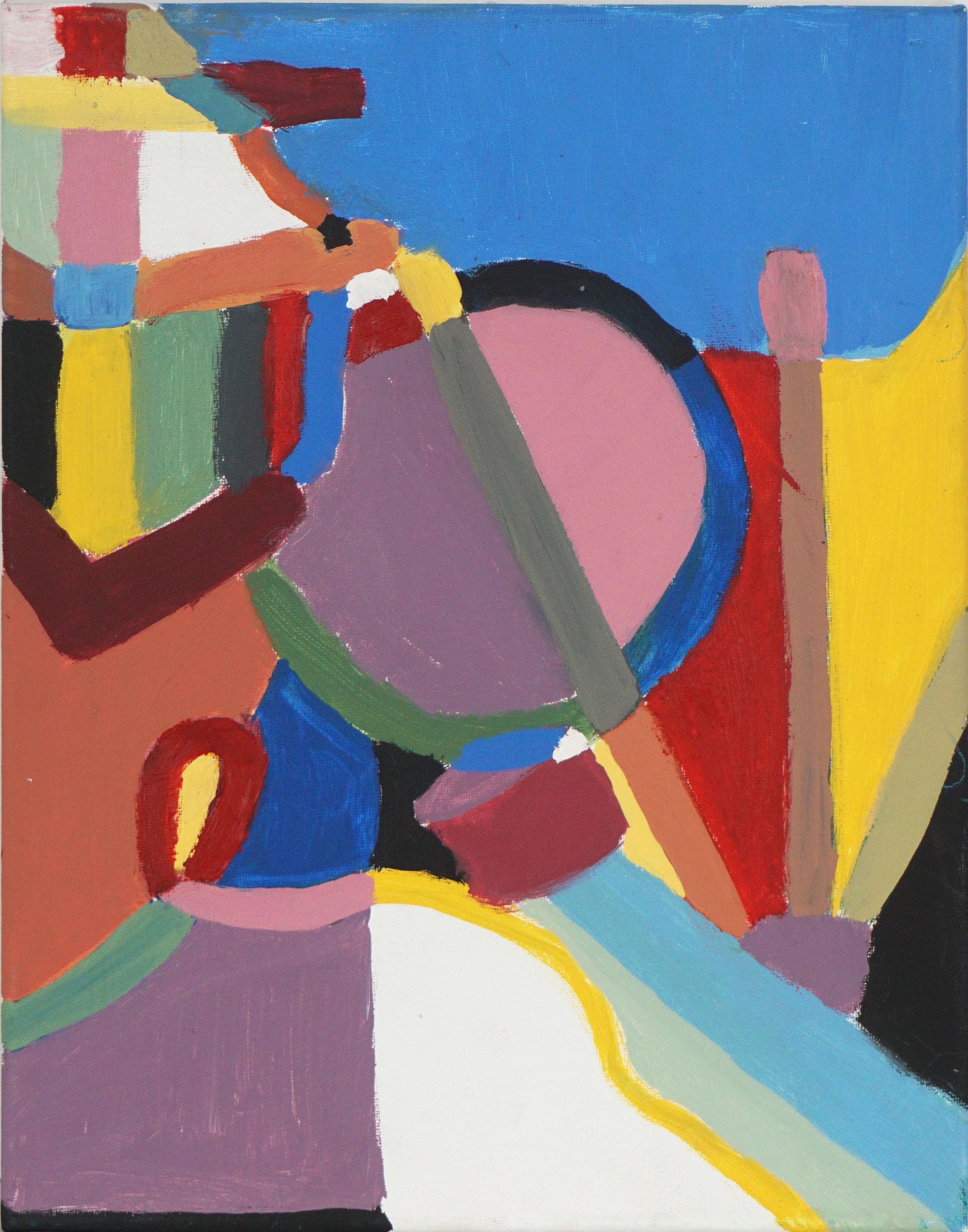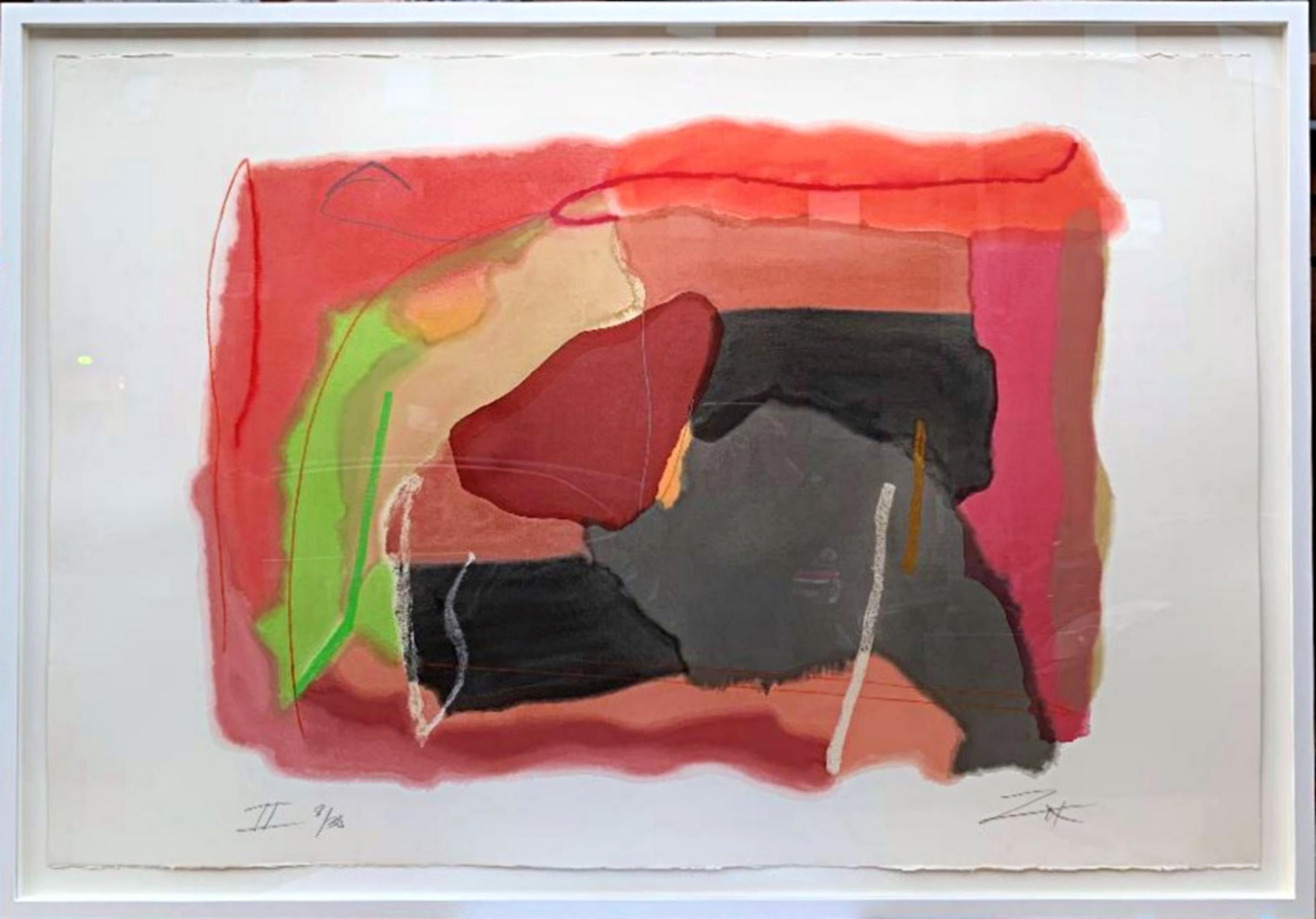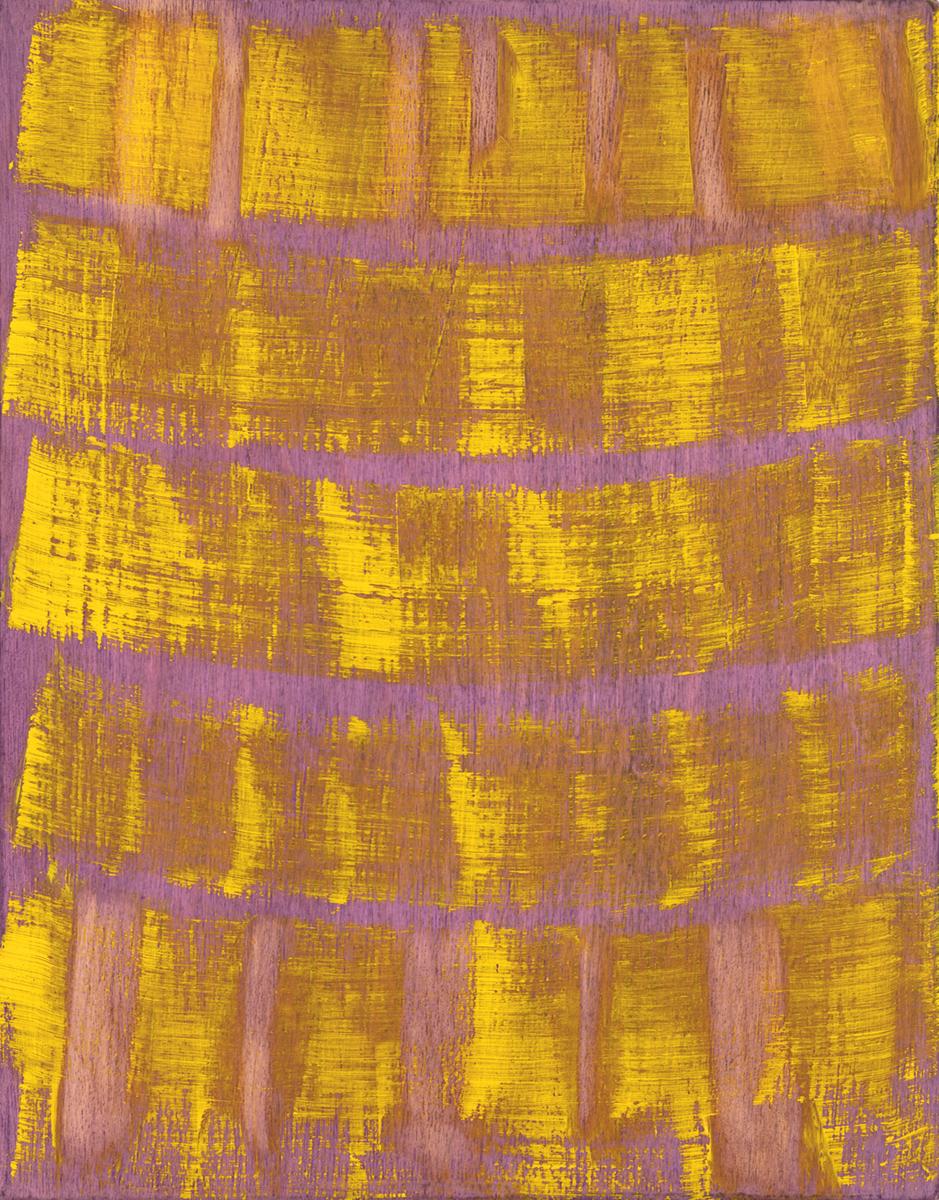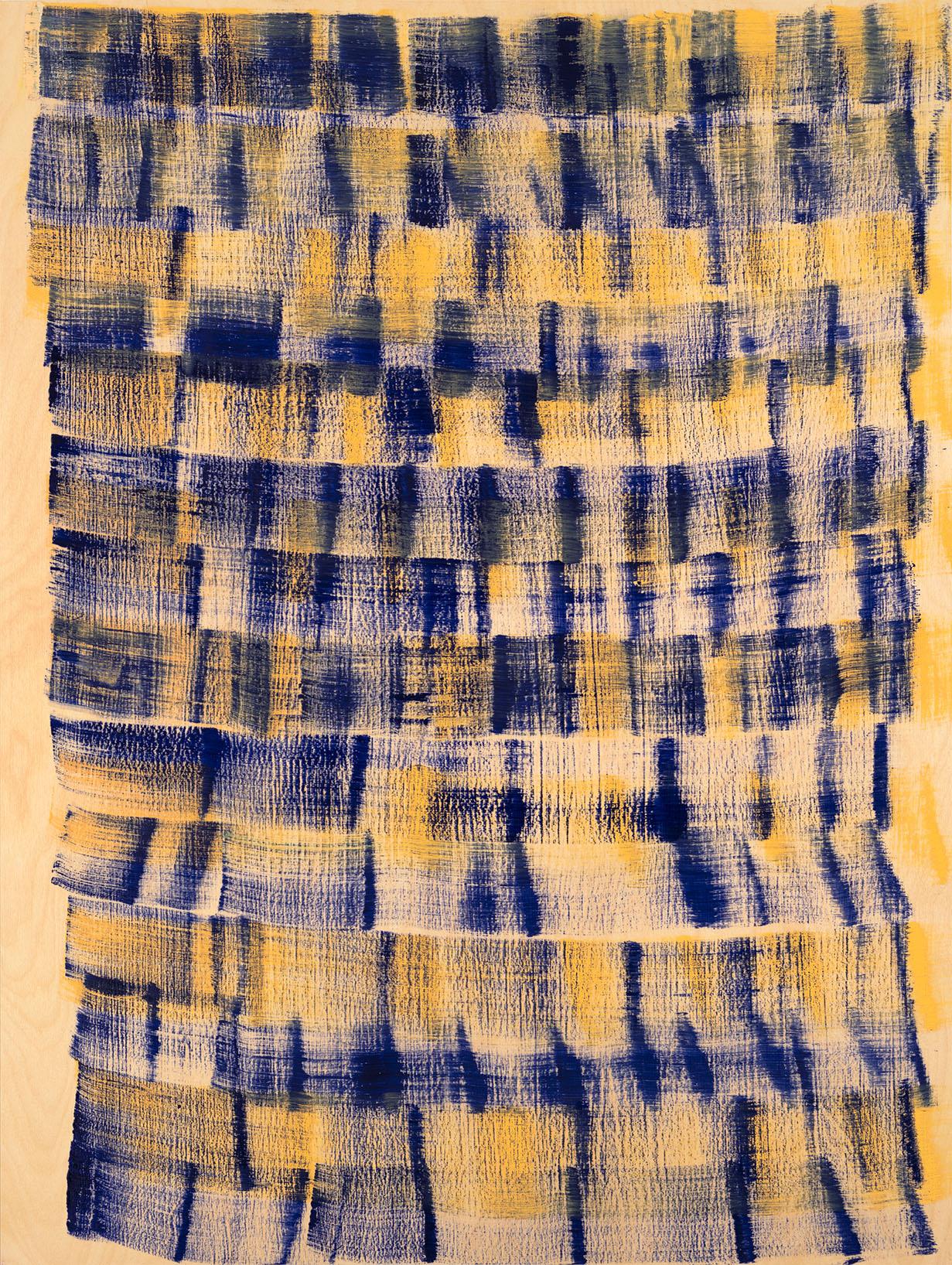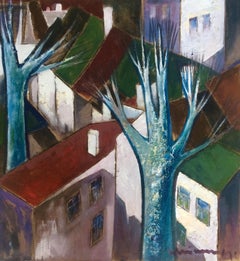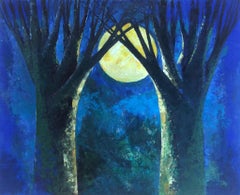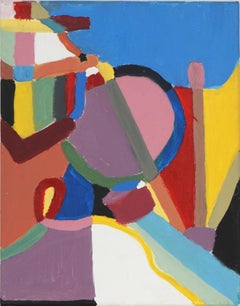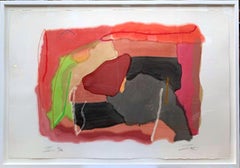Items Similar to Composition 7. 1996, oil on board, 81x65 cm
Want more images or videos?
Request additional images or videos from the seller
1 of 5
Olgerts JaunarajsComposition 7. 1996, oil on board, 81x65 cm1996
1996
About the Item
Composition 7. 1996, oil on board, 81x65 cm
Abstract composition with orange blue fields and black circle
Olgerts Jaunarajs (1907-2003)
He was so-called legend of abstract expressionism in the Latvian art.
1927. – 28. – studies at the University of Latvia, Faculty of Architecture;
1929. – 36. – graduated from the Art Academy of Latvia, (landscape course with V. Purvitis);
1940. – the Secretary of the Labour Union of artists and the director at art cooperative, together with B. Dannenhirss un A. Lapins acted actively in the reorganizing art life;
1944. – 50. – worked as an assistant at the Department of Drawing, at Art Academy of Latvia.
1944. – A Member of Artists’ Union - excluded for formalism and later restored in the Union;
1951. – 59. – worked as an artist at the „Zvaigzne” magazine, dealt with popularization of arts;
He took part at exhibitions since 1934.
Solo exhibitions:
Riga – 1982., 1990., 1994., Valka – 1982., Saldus – 1982., Straupe – 1982., Daugavpils – 1983., Koknese – 1983., Jekabpils – 1984.
After graduating from the Academy he painted landscapes in the styles of V. Purvitis. 1960. – 70. – he made abstract paintings and also aquarelle paintings. 1970. – 80. turned to realistic painting.
- Creator:Olgerts Jaunarajs (1907 - 2003, Latvian)
- Creation Year:1996
- Dimensions:Height: 31.89 in (81 cm)Width: 25.6 in (65 cm)Depth: 0.08 in (2 mm)
- Medium:
- Movement & Style:
- Period:
- Condition:
- Gallery Location:Riga, LV
- Reference Number:1stDibs: LU143727770892
About the Seller
5.0
Gold Seller
Premium sellers maintaining a 4.3+ rating and 24-hour response times
Established in 2002
1stDibs seller since 2020
188 sales on 1stDibs
Typical response time: 2 hours
- ShippingRetrieving quote...Shipping from: Riga, Latvia
- Return Policy
Authenticity Guarantee
In the unlikely event there’s an issue with an item’s authenticity, contact us within 1 year for a full refund. DetailsMoney-Back Guarantee
If your item is not as described, is damaged in transit, or does not arrive, contact us within 7 days for a full refund. Details24-Hour Cancellation
You have a 24-hour grace period in which to reconsider your purchase, with no questions asked.Vetted Professional Sellers
Our world-class sellers must adhere to strict standards for service and quality, maintaining the integrity of our listings.Price-Match Guarantee
If you find that a seller listed the same item for a lower price elsewhere, we’ll match it.Trusted Global Delivery
Our best-in-class carrier network provides specialized shipping options worldwide, including custom delivery.More From This Seller
View AllHouses of town. 1972, watercolor on paper, 55x75, 5 cm
By Olgerts Jaunarajs
Located in Riga, LV
Houses of town. 1972, watercolor on paper, 55x75,5 cm
Olgerts Jaunarajs (1907-2003)
He was so-called legend of abstract expressionism in the Latvia...
Category
1970s Color-Field Abstract Paintings
Materials
Paper, Watercolor
$710 Sale Price
35% Off
Roofs. 1991, oil on cardboard 91x85 cm
Located in Riga, LV
Laimdots Murnieks had a significant influence on the development of Latvian painting at the end of the 20th century. His work 'Holiday' conveys the feeling lightness and joy, which i...
Category
1990s Modern Landscape Paintings
Materials
Oil, Cardboard
Moonlight. 2000, cardboard, oil, 81x100 cm
Located in Riga, LV
Laimdots Murnieks had a significant influence on the development of Latvian painting at the end of the 20th century. His work 'Holiday' conveys the f...
Category
Early 2000s Modern Landscape Paintings
Materials
Oil, Cardboard
$8,842 Sale Price
20% Off
Two trees and the sun. 2002. Cardboard, oil, 100x81 cm
Located in Riga, LV
Laimdots Murnieks had a significant influence on the development of Latvian painting at the end of the 20th century. His work 'Holiday' conveys the f...
Category
Early 2000s Modern Landscape Paintings
Materials
Oil, Cardboard
$8,842 Sale Price
20% Off
After the rain. 1991, oil on cardboard, 90x83 cm
Located in Riga, LV
Laimdots Murnieks had a significant influence on the development of Latvian painting at the end of the 20th century. His work 'Holiday' conveys the fee...
Category
1990s Modern Landscape Paintings
Materials
Oil, Cardboard
$8,842 Sale Price
20% Off
Spring. 1997, oil on cardboard, 74x85 cm
Located in Riga, LV
Laimdots Murnieks had a significant influence on the development of Latvian painting at the end of the 20th century. His work 'Holiday' conveys the fee...
Category
1990s Modern Landscape Paintings
Materials
Oil, Cardboard
$8,842 Sale Price
20% Off
You May Also Like
Small Abstracted Color Field Painting -- Matchsticks
By Michael Pauker
Located in Soquel, CA
Colorful abstracted color field painting of matchsticks by Bay Area artist Michael Pauker (American, b. 1957), circa 2000. Unsigned, but was acqui...
Category
21st Century and Contemporary Color-Field Abstract Paintings
Materials
Glass, Plastic, Wood, Paper, Oil
$800 Sale Price
20% Off
The garden XI
Located in Zofingen, AG
I created this vibrant tableau with a symphony of strokes that dance across the canvas, intertwining in a tapestry of color and energy. Each stroke is a whisper of emotion, a testame...
Category
2010s Color-Field Abstract Paintings
Materials
Canvas, Oil
$1,044
The garden X
Located in Zofingen, AG
I created this vibrant tableau with a symphony of strokes that dance across the canvas, intertwining in a tapestry of color and energy. Each stroke is a whisper of emotion, a testame...
Category
2010s Color-Field Abstract Paintings
Materials
Canvas, Oil
$1,047
Dexter's Choice, State II, signed mixed media watercolor (unique variant) Framed
By Larry Zox
Located in New York, NY
Larry Zox
Dexter's Choice, State II, ca. 1990
Mixed media, Watercolor pochoir, and Oil stick Wax, Water-Based Crayons, on heavy Arches museum watercolor rag paper with deckled edges
40 × 60 in
101.6 × 152.4 cm
Edition 8/30 (unique variant)
Frame included
Measurements:
Sheet: 40 inches (vertical) by 60 inches (horizontal)
Frame: 42 inches x 62 inches x 1 inch
Dexter's Choice, State # II is a unique, mixed media work from an edition of 30 unique variants done in pochoir, (25 stencils, 14 colors). Here, Zox uses watercolor instead of inks, which is applied to heavy 300 lb. watercolor paper. Although it is a multiple signed and numbered from the edition of 30, each work of art is unique because of how the paper receives the watercolor brush. In addition, this work is created like a mixed media painting because it has 11 lines added by hand with wax and water based crayons and oil sticks. The unique watercolor technique that Zox employed in making "Dexter's Choice" is documented in the textbook, "Screen Printing: Water Based Techniques,Roni Henning, NYIT ".
Dexter's Choice was published by Images Gallery, and this work was acquired directly from the publisher before they sold out. This work is elegantly floated and framed in a white wood frame.
Accompanied by gallery issued Certificate of Guarantee
Larry Zox Biography:
A PAINTER who played an essential role in the Color Field discourse of the 1960s and 1970s, Larry Zox is best known for his intensely and brilliantly colored geometric abstractions that question and violate symmetry.1 Zox stated in 1965: “Being contrary is the only way I can get at anything.” To Zox, this position was not necessarily arbitrary, but instead meant “responding to something in an examination of it [such as] using
a mechanical format with X number of possibilities.”2 What he sought was to “get at the specific character and quality of each painting in and for itself,” as James Monte stated in his introductory essay in the catalogue for Zox’s 1973–1974 solo exhibition at the Whitney Museum of American Art.3 Zox’s robust paintings reveal
a celebrated artist and master of composition who is explored and challenged the possibilities of Post-Painterly Abstraction and Minimalist pictorial conventions.
Zox began to receive attention in the 1960s when he was included in several groundbreaking exhibitions of Color Field and Minimalist art, including Shape and Structure (1965), organized by Henry Geldzahler and Frank Stella for Tibor de Nagy, New York, and Systemic Painting (1966), organized by Lawrence Alloway for the Solomon R. Guggenheim Museum, New York. In 1973–1974, the Whitney’s solo exhibition of Zox’s work gave recognition to his significance in the art scene of the preceding decade. In the following year, he was represented in the inaugural exhibition of the Hirshhorn Museum and Sculpture Garden, Wahsington, DC, which acquired fourteen of his works.
Zox was born in Des Moines, Iowa in 1937. He attended the University of Oklahoma and Drake University, Des Moines, Iowa, and then studied under George Grosz at the Des Moines Art Center. In 1958, Zox moved to New York, joining the downtown art scene. His studio on 20th Street became a gathering place for artists, jazz musicians, bikers, and boxers, and he occasionally sparred with visiting fighters. He later established a studio in East Hampton, a former black smithy used previously by Jackson Pollock.
In his earliest works, such as Banner (1962) Zox created
collages consisting of pieces of painted paper stapled onto sheets of plywood. He then produced paintings that were illusions of collages, including both torn- and trued-edged forms, to which he added a wide range of strong hues that created ambiguous surfaces. In paintings such as For Jean (1963), he omitted the collage aspect of his work and applied flat color areas to create more complete statements of pure color and shape. He then replaced these torn and expressive edges with clean and impersonal lines that would define his work for the next decade.
From 1962 to 1965, he produced his Rotation series, at first creating plywood and Plexiglas reliefs, which turned squares into dynamic polygons. He used these shapes in his paintings as well, employing white as a foil between colors to produce negative spaces that suggest that the colored shapes had only been cut out and laid down instead of painted. The New York Times in 1964 wrote of the works in show such as Rotation B (1964) and of the artist: “The artist is hip, cool, adventurous, not content to stay with the mere exercise of sensibility that one sees in smaller works.”4
In 1965, he began the Scissor Jack series, in which he arranged opposing triangular shapes with inverted Vs of bare canvas at their centers that threaten to split their compositions apart. In several works from this series, Zox was inspired by ancient Chinese water vessels. With a mathematical precision and a poetic license, Zox flattened the three dimensional object onto graph paper, and later translated his interpretation of the vessel’s lines onto canvas with masking tape, forming the structure of the painting.
The Diamond Cut and Diamond Drill paintings...
Category
1990s Color-Field Abstract Drawings and Watercolors
Materials
Crayon, Oil, Watercolor, Monoprint, Mixed Media, Graphite
Emily Berger_Glimmer_oil on wood_14 x 11 x 1 inches_2018_Color Field Painting
By Emily Berger
Located in Darien, CT
Emily Berger’s paintings are based on a structure of repetitive and deliberate gesture that is intuitive but carefully considered. She brushes, wipes, rubs, and scrapes, incorporatin...
Category
2010s Color-Field Abstract Paintings
Materials
Oil, Wood Panel
Emily Berger_Dream of Spain_oil on wood_40 x 30 x 2in_2018._Color Field Painting
By Emily Berger
Located in Darien, CT
Emily Berger’s paintings are based on a structure of repetitive and deliberate gesture that is intuitive but carefully considered. She brushes, wipes, rubs, and scrapes, incorporatin...
Category
2010s Color-Field Abstract Paintings
Materials
Oil, Wood Panel
